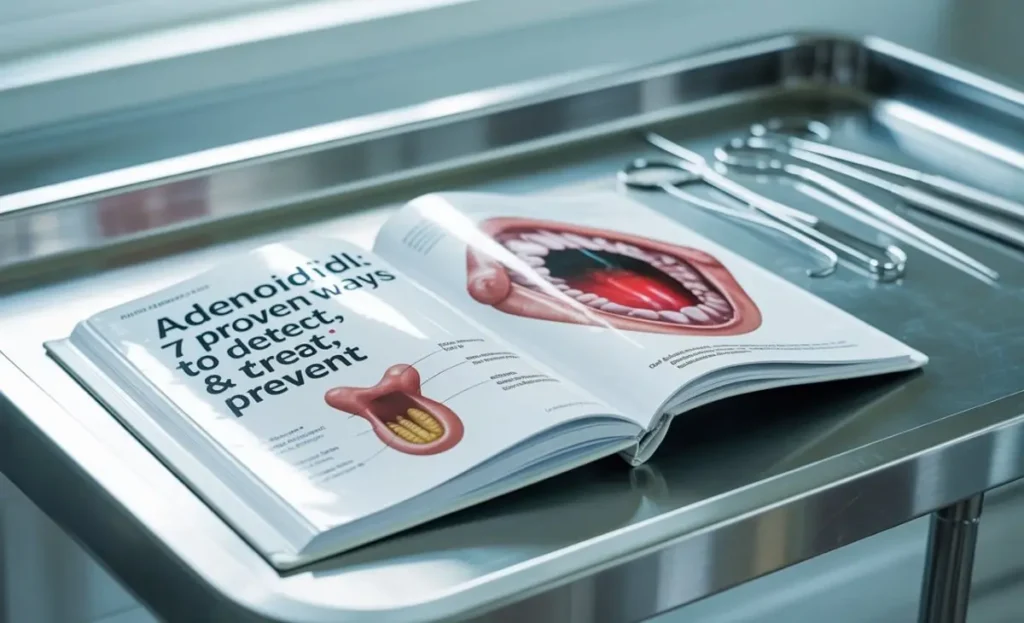Adenoidid is a condition where the adenoids — a small mass of lymphatic tissue at the back of the nasal cavity — become swollen or infected. This condition is most common in children but can occasionally occur in adults. Imagine a child who struggles to breathe through the nose, snores loudly at night, and wakes up feeling tired. In many cases, repeated ear infections or nasal blockages point to adenoidid. While the adenoids play a crucial role in fighting infections, their inflammation can lead to ongoing breathing problems, sleep disturbances, and hearing issues.
A Real-Life Case: Aarav’s Story
Aarav, a six-year-old boy, had been suffering from blocked nasal breathing, loud snoring, and frequent ear infections for months. His parents initially thought it was seasonal flu, but the problem persisted. A specialist’s examination revealed enlarged adenoids causing adenoidid. After trying antibiotics and steam therapy, Aarav eventually underwent a minor adenoidectomy surgery. Within weeks, his breathing improved, his snoring disappeared, and his school concentration returned to normal.
Causes of Adenoidid
It often occurs due to viral or bacterial infections, especially in children exposed to crowded environments such as schools or daycare centers. The common cold, influenza, and bacteria like Streptococcus are frequent triggers. Environmental factors, including dust, allergens, and secondhand smoke, can worsen the problem. In some cases, repeated sinus infections weaken the adenoids’ defense function, making them more prone to swelling.
Symptoms of Adenoidid
Children and adults with adenoidid often experience persistent nasal congestion that forces them to breathe through the mouth. This may be accompanied by loud snoring or restless sleep. Hearing problems can develop due to fluid buildup in the middle ear. A nasal-sounding voice, difficulty swallowing, and fatigue are also common indicators. Unlike a short-term cold, these symptoms persist for weeks, often leading parents to seek medical help.
Diagnosis Process
Doctors diagnose adenoidid through a physical examination and, if needed, further tests. They may use a small scope to look at the adenoids directly or request an X-ray of the neck to assess their size. If ear problems are suspected, hearing tests may be recommended. In cases of suspected bacterial infection, a throat swab can help identify the cause. These tests are painless and safe for children.
Treatment Options
Mild cases of It often resolve with rest, hydration, and nasal saline sprays. When bacteria are involved, antibiotics can help clear the infection. If symptoms become chronic and interfere with breathing, sleep, or hearing, surgery to remove the adenoids — called adenoidectomy — may be necessary. This short procedure typically has a quick recovery time of one to two weeks. Pain relief and fever control during recovery ensure comfort for the patient.
Home Remedies and Practical Tips
- Use a humidifier in the bedroom at night to keep airways moist.
- Encourage warm saline gargles two to three times a day.
- Offer vitamin-rich fruits and fluids to boost immunity.
- Avoid exposure to cigarette smoke or strong chemical fumes.
When Surgery Becomes Necessary
Surgery is considered when the adenoids cause repeated ear infections, persistent nasal blockage, or sleep apnea despite medical treatment. For children, constant mouth breathing and loud snoring can affect facial growth and speech development. Adenoidectomy is a safe procedure, and in many cases, it is combined with tonsil removal if both tissues are enlarged.
Preventing Adenoidid
- Teach children proper handwashing to reduce infection spread.
- Ensure vaccinations for flu and other respiratory illnesses are up to date.
- Keep bedding clean and dust-free to avoid allergen exposure.
- Limit contact with individuals showing cold or flu symptoms.
FAQs
What is the fastest way to relieve adenoidid symptoms?
Steam inhalation and nasal saline sprays can bring quick relief, but antibiotics may be necessary if bacteria are the cause.
Can adenoidid go away without surgery?
Yes, mild cases often improve with medication and supportive care. Surgery is only for chronic or severe cases.
Is adenoidid dangerous?
If left untreated, it can lead to hearing problems, breathing difficulties, and even sleep apnea.
Can adults suffer from adenoidid?
Yes, though it is rare. It can occur if residual adenoid tissue remains or regrows.
How long does adenoidid last?
Viral cases may resolve within one to two weeks, while chronic cases can persist for months.
Conclusion
Adenoidid is common, treatable, and preventable if recognized early. Timely medical attention can prevent long-term breathing and hearing complications. Parents should pay close attention to persistent symptoms, especially in children, and avoid assuming it’s just a seasonal cold. Whether through home care, medication, or surgery, early action ensures healthier breathing, better sleep, and improved overall well-being. If symptoms persist, schedule a consultation with an ENT specialist to get a proper diagnosis and treatment plan.





